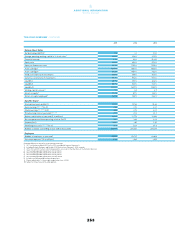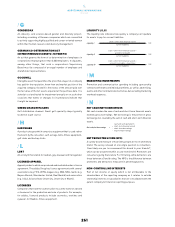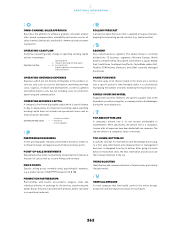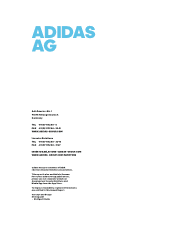Reebok 2015 Annual Report Download - page 266
Download and view the complete annual report
Please find page 266 of the 2015 Reebok annual report below. You can navigate through the pages in the report by either clicking on the pages listed below, or by using the keyword search tool below to find specific information within the annual report.ADDITIONAL INFORMATION
Glossary
262
5
/ O
OMNI-CHANNEL SALESAPPROACH
Describes the ambition to achieve a globally consistent product
offer, brand communication, availability and service across all
sales channels (wholesale, retail and e-commerce) and consumer
touchpoints.
OPERATING CASH FLOW
Comprises operating profit, change in operating working capital
and net investments.
OPERATING OVERHEAD EXPENSES
Expenses which are not directly attributable to the products or
services sold, such as costs for distribution, marketing overhead
costs, logistics, research and development, as well as general
and administrative costs, but not including costs for promotion,
advertising and communication.
OPERATINGWORKING CAPITAL
A company’s short-term disposable capital which is used to finance
its day-to-day business. In comparison to working capital, operating
working capital does not include non-operational items such as
financial assets and taxes.
/ P
PERFORMANCE BUSINESS
In the sporting goods industry, performance business relates to
technical footwear and apparel used primarily in doing sports.
POINT-OF-SALE INVESTMENTS
Expenditures that relate to advertising and promotion initiatives at
the point of sale as well as to store fittings and furniture.
PRICE POINTS
Specific selling prices, normally using ‘psychological’ numbers,
e.g. a product price of US $ 99.99 instead of US $ 100.
PROMOTION PARTNERSHIPS
Partnerships with events, associations, leagues, clubs and
individual athletes. In exchange for the services of promoting the
adidas Group, the party is provided with products and/or cash and/
or promotional materials.
/ R
ROLLING FORECAST
A projection about the future that is updated at regular intervals,
keeping the forecasting period constant (e.g. twelve months).
/ S
SEGMENT
Also called business segment. The adidas Group is currently
divided into 13 business segments: Western Europe, North
America, Greater China, Russia/CIS, Latin America, Japan, Middle
East, South Korea, Southeast Asia/Pacific, TaylorMade-adidas Golf,
Reebok-CCM Hockey, Runtastic and Other centrally managed
businesses.
SHARE TURNOVER
The total value of all shares traded in the share price currency
over a specific period of time (normally daily). It is calculated by
multiplying the number of shares traded by the respective price.
SINGLE-SOURCING MODEL
Supply chain activities limited to one specific supplier. Due to the
dependency on only one supplier, a company can face disadvantages
during the sourcing process.
/ T
TOPAND BOTTOM LINE
A company’s bottom line is its net income attributable to
shareholders. More specifically, the bottom line is a company’s
income after all expenses have been deducted from revenues. The
top line refers to a company’s sales or revenues.
TOP-DOWN, BOTTOM-UP
A specific concept for information and knowledge processing.
In a first step, information and empowerment of management
decisions is delegated from top to bottom. After going into more
detail on the bottom level, the final information and decision are
then transported back to the top.
TREND SCOUTING
Identification and commercialisation of future trends, particularly
lifestyle trends.
/ V
VERTICAL RETAILER
A retail company that (vertically) controls the entire design,
production and distribution processes of its products.
Operating cash flow =
operating profit
+/– change in operating working capital
+/– net investments
(capital expenditure less depreciation
and amortisation)
Operating working capital =
accounts receivable
+ inventories
– accounts payable


















